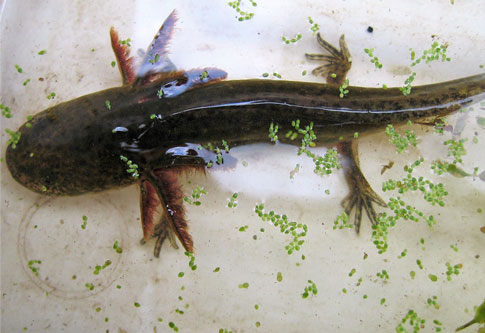The amphibian species of Ohio are an interesting group whose ecology and identification will be thoroughly covered in this course. The course will also cover how some of Ohio's amphibian species are used to assess wetlands and headwater streams. The Amphibian Index of Biotic Integrity (AmphIBI) is a bioassessment method that uses amphibians as indicators of wetland ecological condition. Primary Headwater Habitat (PHWH) biological methods also use amphibians, specifically salamanders, to determine the quality of headwater streams.
The AmphIBI and the PHWH amphibian assessments will be covered in this course. Both require a firm understanding of the field protocols used to collect amphibians and the methods to make accurate identifications of amphibians to species level. Users must then know how to utilize the collected data to develop AmphIBI scores, assign wetland categories, determine reproducing stream salamander species present, and make headwater stream classification determinations. All of the information to make accurate species identifications and to determine appropriate wetland categories and stream classifications is covered in depth throughout the course.
Day One: Classroom, Laboratory and Field Instruction
The ecology of all Ohio amphibian species and the history behind the development of the AmphIBI and PHWH methods and protocols will be covered. The important morphological features that lead to identification of Ohio adult and larval amphibians will be presented in the laboratory. Each participant will have a microscope, amphibian voucher specimens, and appropriate written keys to learn the important characteristics that distinguish between adult and larval forms of species of salamanders, frogs and toads. The instructor will use a microscope that projects images on a screen to clearly indicate exactly which taxonomic features are most important to identification of the various larval forms of the species. The day will finish in the field at a local vernal pool where attendees will deploy funnel traps while learning AmphIBI field sampling protocols.
Day Two: Field Training
Participants will return to the vernal pool to gather the traps, identify and release adult amphibians, and collect and preserve larval amphibians. We will then visit a headwater stream and learn the methods for collecting salamanders. Adult salamanders will be identified and released, and larval salamanders will be collected and preserved.
Day Three: Laboratory and Classroom Instruction
We will be in the laboratory to identify the amphibians collected using the keys covered during Day One. Additional preserved specimens will be reviewed to ensure that all participants are comfortable in distinguishing the characteristics that confirm identification to species. The day will end with an explanation of the metrics that comprise the AmphIBI and how salamanders are used to classify primary headwater streams. Participants will also learn how the data collected in the field is used to calculate AmphIBI scores and PHWH classifications. We will conclude the course with a test on the material covered.
Results
Participants will finish the course having strong skills in identification and an understanding of the ecology of Ohio amphibians. They will also have the ability to monitor and assess vernal pools using the AmphIBI and to classify headwater streams based on their salamander communities. Upon completing the course participants will be familiar with the important principles involved in amphibian conservation and headwater stream and vernal pool protection, enhancement, management and restoration. Participants will receive a certificate documenting successful course completion.
* This course is certified by the Society of Wetland Scientists Professional Certification Program.

